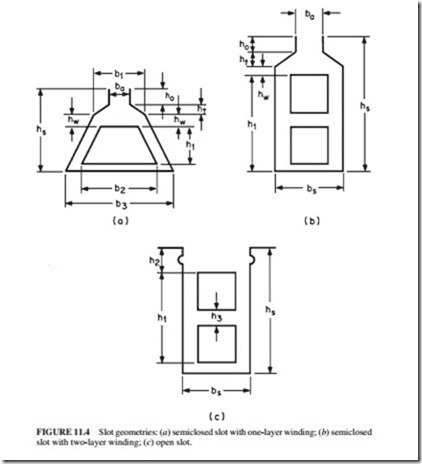POLE PITCH: ELECTRICAL DEGREES
The pole pitch A is defined as
![]() where P is the number of poles. The pole pitch is an arc, given in degrees or radians. For example, if P 2, then A 180°.
where P is the number of poles. The pole pitch is an arc, given in degrees or radians. For example, if P 2, then A 180°.
 AIR GAP AND MAGNETIC CIRCUIT OF A SYNCHRONOUS MACHINE
AIR GAP AND MAGNETIC CIRCUIT OF A SYNCHRONOUS MACHINE
Air Gap. The radial distance between the rotor and the stator is called the air gap. It is represented in Figs. 11.1 and 11.2 by the symbol g.
Stator. The stator is made of magnetic lam- inations stacked axially. Insulating material separates the laminations. It is made from either varnish applied in a liquid form or oxides formed in the heat-treating process. The lamina- tions are held together by any of the following methods:
● Bolts
● Welding the outer circumference of the lam- inations
● Pressure bonding using the insulating material as the bonding agent
Radial bolts are used to fasten the stator stack to the housing. Figure 11.3 illustrates a typical stator lamination. The three sections in it are the slots, the teeth, and the stator yoke, or back iron. Figure 11.4 illustrates the three common geometries of stator slots in large synchronous machines.
The laminations are normally made of 3.5 percent silicon steel or carbon steel, such as ASA 1020. The thickness of a typical lami-
nation in a large synchronous machine operating at 60 Hz is 0.37 to 0.635 mm (0.014 to 0.025 in). The stacking factor for large synchronous machines is 0.92 to 0.98.
Rotor. The salient-pole rotor described above is used commonly in synchronous motors and slow-speed generators driven by hydraulic turbines. The cylindrical rotor is commonly used in high-speed generators driven by steam or gas turbines. The rotor of a synchronous machine has a damper, or amortisseur, winding in addition to the field winding. This wind- ing is identical to the one in a squirrel-cage induction machine. It dampens the mechanical oscillations of the rotor in the synchronous machine by supplying a positive or negative induction torque. In some applications, it is used to start a synchronous machine as an induction motor.
The damper winding is made of copper or aluminum bars. The bars are shorted together electrically at each end by a shorting ring around their outer circumference. The shorting rings are made of the same material as the bars. In some cases, a lamina- tion made of the same material as the bars and matching the steel laminations is used to short the bars. The bars are brazed to the end ring or end lamination to achieve good electrical connection.
The field winding is wound around a magnetic section of constant cross-sectional area under the pole face. In some designs, the field winding is preformed and installed over the inner pole section before mounting the pole-face section.
Rotors of relatively smaller machines are made of magnetic laminations. Large rotors are normally made of a single forging. This allows them to withstand the significant mechanical, electrical, and thermal stresses experienced during normal operation. The rotor laminations are made of the same material as the ones used in the stator. They are either silicon steel or carbon steel.
The slip rings are mounted at one end of the rotor shaft. The field winding is connected to the slip rings through radial bolts and up-shaft leads (known commonly as D bolts). The slip rings, radial bolts, and D bolts are insulated from the shaft. The external power supply is connected to the slip rings through copper-graphite or liquid-metal brushes.

